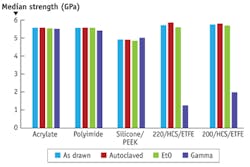ANDREI STOLOV and ANTHEA CROGHAN
Fiber optics provides key benefits to numerous biomedical disciplines, from endoscopy to medical sensing and including cardiology, dentistry, ophthalmology, general surgery, and urology. Successful implementation for these applications is dependent on effective sterilization, but the sterilization process can be harsh on fiber, and the wrong choice of method can degrade the performance of the overall system.
Ideally, sterilization should eliminate all microorganisms from the fiber, and leave optical attenuation and mechanical strength unaffected. Finding no studies on the effects of sterilization on optical fiber, researchers at OFS Specialty Photonics Division (Avon, CT) undertook an investigation to determine the impact of three different sterilization approaches on specialty fibers with five different polymer coatings. The results highlight that careful attention to sterilization can spell the difference between a system that performs optimally and one that introduces errors or fails utterly.1
Evaluation specifics
The study investigated silica glass core fibers with an outer diameter (OD) of 200 μm (see table). Four of the fibers had 220 μm doped silica claddings with a numerical aperture (NA) of 0.22, and coatings of dual acrylate, hard polymer, silicone, and polyimide, respectively. The fifth fiber, with an NA of 0.37, had an OFS proprietary fluoroacrylate polymer cladding called hard clad silica (HCS) and an ethylene tetrafluoroethylene (ETFE) jacket. It is important to note that in both the 220 and 200 μm fibers, HCS fluoropolymer simultaneously serves as both a cladding and a coating. Loose 500 m coils with a diameter of about 12 in. were prepared from each fiber.Typically, sterilization involves use of elevated temperatures, chemical treatment, or exposure to radiation. For this study, we used steam sterilization (autoclaving), treatment with ethylene oxide (EtO), and gamma radiation.
Although autoclaving cannot be used with items that are sensitive to heat and moisture, this method is popular because it is fast, safe, and non-toxic. And while EtO can be used with heat-sensitive materials, it also happens to be toxic, carcinogenic, and explosive—and the sterilization process itself requires long periods of time with significant ventilation. Gamma radiation can also be used with items that are sensitive to heat; it produces minimal waste, requires very little outgassing time, and is able to achieve very high sterility assurance levels. Unfortunately, gamma radiation can also cause chemical changes—such as ionization or excitation of polymer molecules—in the materials that it is treating, which may result in chain linking or scission.
Strength testing
To test strength, we chose parameters typical for medical applications, and determined the cumulative failure probability for each of the five fiber types (see graph showing median strength).We selected 20 as the maximum number of autoclave cycles for this study. After every five cycles, we removed a 3 m section of each sample from the fiber coils and tested it for strength. Findings showed that autoclaving did not affect the strength of the acrylate, silicone/ETFE, polyimide, and HCS/ETFE coated fibers within 20 consecutive cycles. Besides that, a very minor reduction of nd value (how long the fiber will survive under tension or when bent) for the acrylate-coated fiber is the only apparent effect of autoclaving on the fiber mechanical properties.
EtO treatment conditions applied in this study (0.5 atmospheres of 100% EtO, 60°C, 7.5 hours dwell time) were the same as those commonly used for various medical devices. The study showed no effects of the EtO process on fiber strength, nor did EtO cause chemical degradation of the silica and polymer coatings.
Finally, the gamma radiation dose we applied (40–50 kGy) was also typical for medical sterilization. While a 25 kGy dose is 40% above the minimum to kill the most resistant microorganisms, but actual applied doses are often 25–50 kGy.2 The results showed that exposure to gamma radiation led to a significant strength degradation of fibers with HCS/ETFE coating/buffer layers. At the same time, the mechanical strengths of fibers with acrylate, polyimide, and silicone/PEEK coatings were not affected. It is important to note that adsorption of radiation is cumulative, so using lower radiation doses (≤25 kGy) may still be appropriate, especially for wavelengths above 1000 nm.
Gamma radiation normally affects polymers in two ways, both of which result from excitation or ionization of atoms. The first is chain scission, which is a random rupturing of bonds that reduces the molecular weight (i.e., strength) of the polymer. The second is cross-linking of polymer molecules, which results in the formation of large, three-dimensional molecular networks. For polymers with carbon-carbon chains (backbones), it has been observed that, generally, cross-linking will occur if the carbons have one or more hydrogen atoms attached, whereas scission occurs at tetra-substituted carbons.3
Because strength degradation occurred only in fibers with HCS coating up-buffered with ETFE, it was clear that the problem is related to the coating or buffer chemistry. It seems most likely that interactions with gamma radiation generate hydrofluoric acid as one of the reaction products. Hydrofluoric acid can easily diffuse through the coating and deteriorate the glass surface, which results in significant strength degradation. Apparently, gamma radiation caused very minor changes in polymer chemistry of HCS and/or ETFE that are undetectable by Fourier transform infrared (FTIR), but fatal for the fibers. Because the observed strength degradation is related to the fluorine content in the coating/buffer layers, similar behavior is expected for other types of commercially available fluorinated polymer-coated fibers.
Attenuation effects
We used two independent approaches to evaluate attenuation of the fiber. Photon Kinetics' (Beaverton, OR) 8000 Production and Laboratory optical time-domain reflectometry (OTDR) instrument performed measurements at 850 nm. The OTDR approach is insensitive to quality of the fiber end faces, so it enables accurate evaluation at a single wavelength. In addition, a custom-made spectral bench allowed us to determine spectral attenuation in the 600–1100 nm region and thus provided important information on chemical changes in both the fiber core and the cladding.
The results showed that EtO treatment did not affect attenuation at 850 nm. Multiple autoclaving cycles caused slight changes for silicone/ polyether ether ketone (PEEK) and 200/HCS/ETFE fibers only. In contrast, gamma radiation affected the fiber attenuation significantly; the optical signal transmitted through 220/HCS/ETFE and 200/HCS/ETFE fibers did not even register after the fibers were treated. Apparently, gamma radiation so weakened these fibers that further handling led to multiple disruptions throughout the fiber length.
The attenuation spectra enable detailed analysis of the effects of sterilization, and reveal that the as-drawn (unsterilized), autoclaved, and EtO-treated fibers are nearly identical. Mechanical strength of fibers with coatings containing fluorine degraded rapidly upon the exposure to gamma radiation, which resulted in additional losses that gradually increased at shorter wavelengths. Clearly, gamma radiation is not the best method of sterilization for optical fiber.
By contrast, EtO treatment did not harm the fibers' mechanical and optical properties.
Likewise, multiple autoclaving cycles had only minor impact on the fiber strength: The only apparent effect was a minor decrease of nd for the fiber with dual acrylate coating. For most fibers, attenuation was affected weakly or not at all. The only exception was the polymer-clad fiber, where OH absorption peaks developed in the spectra following autoclaving.
Application of results
Sterilization is a necessary step in creating medical-grade optical fiber. As this study demonstrates, choosing a method that balances invasiveness with effectiveness is necessary to ensure top performance without sacrificing safety. Although this study was relatively small scale, its results can be helpful for choosing a sterilization method and/ or manufacturer.
REFERENCES
1. A. A. Stolov et al., "Effects of sterilization methods on key properties of specialty optical fibers used in medical devices," Proc. SPIE, 8576, 8576-5 (2013).
2. A. Tallentire, Radiat. Phys. Chem., 15, 1, 83–89 (1980).
3. K. J. Hemmerich, Medical Device and Diagnostic Industry, http://www.mddionline.com/article/polymer-materials-selection-radiation-sterilized-products (2000).
Andrei Stolov, Ph.D., is a coatings scientist and Anthea Croghan is a technical writer with OFS Specialty Photonics Division, www.specialtyphotonics.com. Contact the authors at [email protected].


